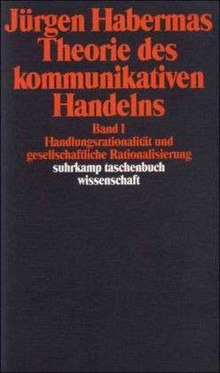The Theory of Communicative Action

Cover of the German edition
|
|
| Author | Jürgen Habermas |
|---|---|
| Original title | Theorie des kommunikativen Handelns |
| Translator | Thomas McCarthy |
| Country | Germany |
| Language | German |
| Subject |
Sociology Philosophy |
| Published | 1981 |
| Media type | |
| Pages | 465 (English edition, vol. 1) 457 (English edition, vol. 2) |
| ISBN | (English edition, vol. 1) 0-8070-1401-x (English edition, vol. 2) |
The Theory of Communicative Action (German: Theorie des kommunikativen Handelns) is a two-volume 1981 book by Jürgen Habermas, in which Habermas continues his project of finding a way to ground "the social sciences in a theory of language", which had been set out in On the Logic of the Social Sciences (1967). The two volumes are Reason and the Rationalization of Society (Handlungsrationalität und gesellschaftliche Rationalisierung), in which Habermas establishes a concept of communicative rationality, and Lifeworld and System: A Critique of Functionalist Reason (Zur Kritik der funktionalistischen Vernunft), in which Habermas creates the two level concept of society and lays out the critical theory for modernity. After writing The Theory of Communicative Action, Habermas expanded upon the theory of communicative action by using it as the basis of his theory of morality, democracy, and law. The work has inspired many responses by social theorists and philosophers, and in 1998 was listed by the International Sociological Association as the eighth most important sociological book of the 20th century.
The theory of communicative action is a critical project which reconstructs a concept of reason which is not grounded in instrumental or objectivistic terms, but rather in an emancipatory communicative act. This reconstruction proposes "human action and understanding can be fruitfully analysed as having a linguistic structure", and each utterance relies upon the anticipation of freedom from unnecessary domination. These linguistic structures of communication can be used to establish a normative understanding of society. This conception of society is used "to make possible a conceptualization of the social-life context that is tailored to the paradoxes of modernity."
This project started after the critical reception of Habermas's book Knowledge and Human Interests (1968), after which Habermas chose to move away from contextual and historical analysis of social knowledge toward what would become the theory of communicative action. The theory of communicative action understands language as the foundational component of society and is an attempt to update Marxism by "drawing on Systems theory (Luhmann), developmental psychology (Piaget, Kohlberg), and social theory (Weber, Durkheim, Parsons, Mead, etc.)".
...
Wikipedia
